Solar eclipse of June 21, 2001
| Solar eclipse of June 21, 2001 | |
|---|---|
|
Totality from Lusaka, Zambia by the Williams College eclipse expedition | |
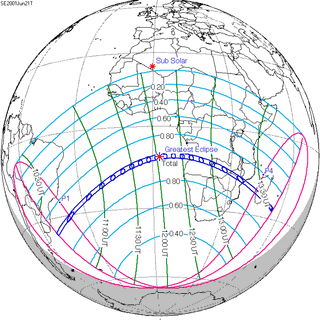 Map | |
| Type of eclipse | |
| Nature | Total |
| Gamma | -0.5701 |
| Magnitude | 1.0495 |
| Maximum eclipse | |
| Duration | 297 sec (4 m 57 s) |
| Coordinates | 11°18′S 2°42′E / 11.3°S 2.7°E |
| Max. width of band | 200 km (120 mi) |
| Times (UTC) | |
| (P1) Partial begin | 9:33:04 |
| (U1) Total begin | 10:35:59 |
| Greatest eclipse | 12:04:46 |
| (U4) Total end | 13:31:37 |
| (P4) Partial end | 14:35:25 |
| References | |
| Saros | 127 (57 of 82) |
| Catalog # (SE5000) | 9511 |
A total solar eclipse took place on June 21, 2001, with a magnitude of 1.0495. A solar eclipse occurs when the Moon passes between Earth and the Sun, thereby totally or partly obscuring the image of the Sun for a viewer on Earth. A total solar eclipse occurs when the Moon's apparent diameter is larger than the Sun's, blocking all direct sunlight, turning day into darkness. Totality occurs in a narrow path across Earth's surface, with the partial solar eclipse visible over a surrounding region thousands of kilometres wide.
Visibility
It was visible from a narrow corridor in the southern Atlantic Ocean and southern Africa. A partial eclipse was seen from the much broader path of the Moon's penumbra, including eastern South America and most of Africa.
Images

Related eclipses
Solar eclipses 2000-2003
Each member in a semester series of solar eclipses repeats approximately every 177 days and 4 hours (a semester) at alternating nodes of the Moon's orbit.
Note: Partial solar eclipses on February 5, 2000 and July 31, 2000 occur in the previous lunar year set.
| Ascending node | Descending node | |||
|---|---|---|---|---|
| Saros | Map | Saros | Map | |
| 117 | July 1, 2000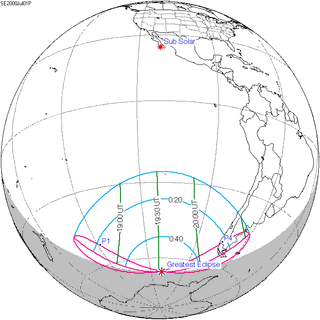 Partial (south) |
122 | December 25, 2000 Partial (north) | |
127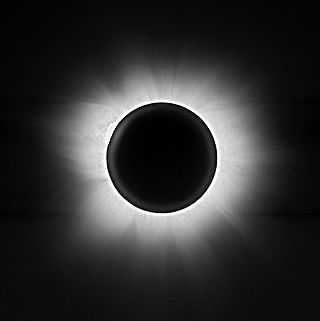 Totality from Zambia | June 21, 2001 Total |
132 Partial from Minneapolis, MN | December 14, 2001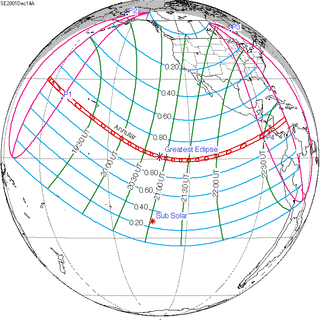 Annular | |
137.jpg) Partial Los Angeles, CA | June 10, 2002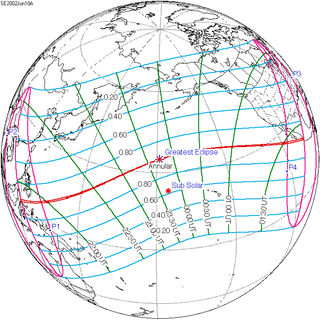 Annular |
142 | December 4, 2002 Total | |
147 Partial from Belfort | May 31, 2003 Annular |
152 | November 23, 2003 Total | |
Saros 127
It is a part of Saros cycle 127, repeating every 18 years, 11 days, containing 82 events. The series started with partial solar eclipse on October 10, 991 AD. It contains total eclipses from May 14, 1352 through August 15, 2091. The series ends at member 82 as a partial eclipse on March 21, 2452. The longest duration of totality was 5 minutes, 40 seconds on August 30, 1532.[1]
Series members 52-62 occur between 1901 and 2100:
| 52 | 53 | 54 |
|---|---|---|
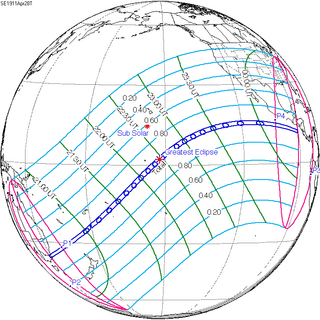 April 28, 1911 |
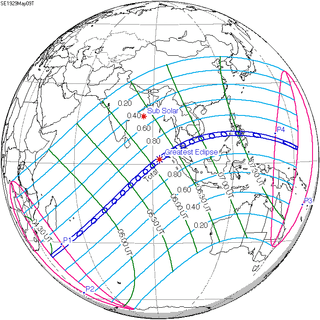 May 9, 1929 |
 May 20, 1947 |
| 55 | 56 | 57 |
 May 30, 1965 |
 June 11, 1983 |
 June 21, 2001 |
| 58 | 59 | 60 |
 July 2, 2019 |
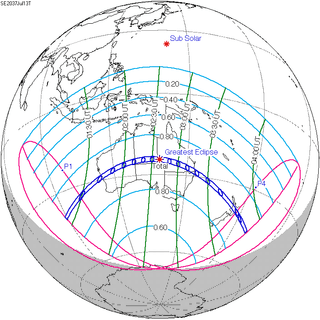 July 13, 2037 |
 July 24, 2055 |
| 61 | 62 | |
 August 3, 2073 |
 August 15, 2091 |
Metonic series
The metonic series repeats eclipses every 19 years (6939.69 days), lasting about 5 cycles. Eclipses occur in nearly the same calendar date. In addition the octon subseries repeats 1/5 of that or every 3.8 years (1387.94 days).
This series has 21 eclipse events between June 21, 1982, and June 21, 2058.
| June 21 | April 8-9 | January 26 | November 13-14 | September 1-2 |
|---|---|---|---|---|
| 117 | 119 | 121 | 123 | 125 |
 June 21, 1982 |
 April 9, 1986 |
 January 26, 1990 |
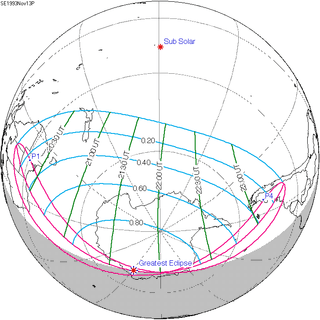 November 13, 1993 |
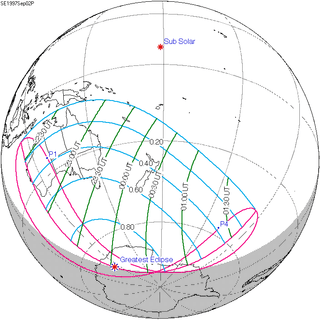 September 2, 1997 |
| 127 | 129 | 131 | 133 | 135 |
 June 21, 2001 |
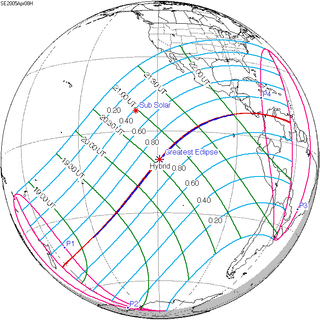 April 8, 2005 |
 January 26, 2009 |
 November 13, 2012 |
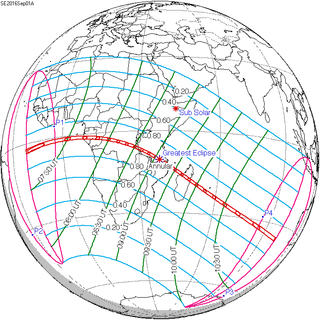 September 1, 2016 |
| 137 | 139 | 141 | 143 | 145 |
 June 21, 2020 |
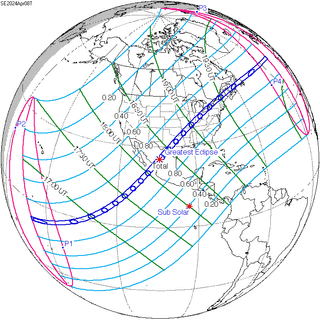 April 8, 2024 |
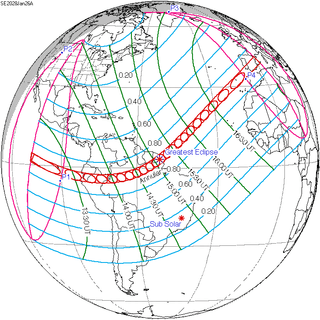 January 26, 2028 |
 November 14, 2031 |
 September 2, 2035 |
| 147 | 149 | 151 | 153 | 155 |
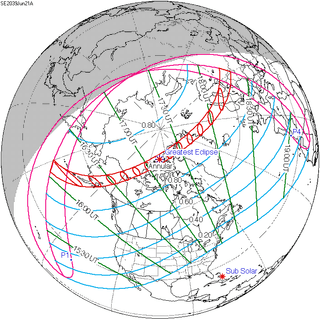 June 21, 2039 |
 April 9, 2043 |
 January 26, 2047 |
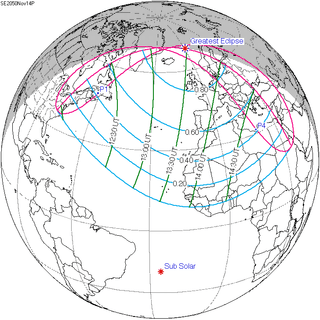 November 14, 2050 |
 September 2, 2054 |
| 157 | ||||
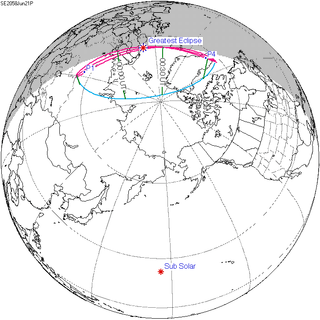 June 21, 2058 |
Notes
References
- Fred Espenak and Jay Anderson. "Total Solar Eclipse of 2001 June 21". NASA, November 2004.
- Earth visibility chart and eclipse statistics Eclipse Predictions by Fred Espenak, NASA/GSFC
- Map Google
| Wikimedia Commons has media related to Solar eclipse of 2001 June 21. |
Photos:
- Spaceweather.com solar eclipse gallery
- Prof. Druckmüller's eclipse photography site. Zambia
- Prof. Druckmüller's eclipse photography site. Angola
- KryssTal - Eclipse in Zimbabwe - in a school by the Ruya River.
- Images from Zimbabwe by Crayford Manor House Astronomical Society
- APOD 6/22/2001, Eclipse in African Skies, totality from Lusaka, Zambia
- APOD 7/6/2001, Bakasa Eclipse Sequence, totality from Bakasa, Zimbabwe
- APOD 7/26/2001, Madagascar Totality, from southern Madagascar
- APOD 11/22/2003, Moon AND Sun, totality from Chisamba, Zambia

